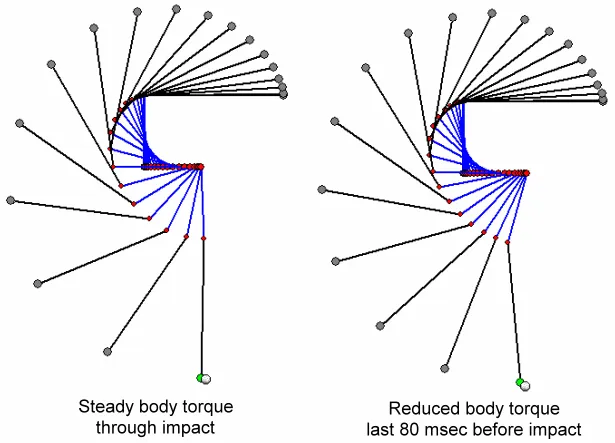EJS GOLF BLOG
Learn about the golf swing and what you can do to improve your score on the golf course. Fill out the form below if you have any questions or want to set up a time to talk.
Mastering the Art of Golf with Coach Erik Schjolberg
I’m Coach Erik Schjolberg, and welcome to the EJS Golf blog—Scottsdale’s authority on science-driven ball-striking. Here you’ll find in-depth analyses of swing mechanics, data-backed breakdowns of impact and launch dynamics, and actionable practice routines designed to rewire your muscle memory from day one. Each post peels back the curtain on cause-and-effect in your swing, whether you’re chasing Tour-level precision, collegiate consistency, or lower weekend scores. Dive into our deep-dive articles, master the drills that drive real improvement, and transform your game with proven science and strategy.
But let’s be clear: golf isn’t only about perfecting swing mechanics. The mental battle you fight on each tee is often the one that determines whether you stay in the game or walk off the course. Here, we’ll tackle the psychological hurdles—the pressure of a tight leaderboard, the frustration when a swing fails under stress, the self-doubt that creeps in after a bad hole. You’ll learn evidence-based mental strategies—visualization routines, pre-shot rituals, stress-management techniques—that fortify your focus and resilience. Mastering these mind-set tools is just as critical as dialing in your impact position, and I’ll show you exactly how to integrate mental training into your practice for lasting confidence on every shot.
Explore Our Blogs

Science of Golf Swing Speed — How I Add 20 Yards by Harnessing Pure Physics
Science of Golf Swing Speed — How I Add 20 Yards by Harnessing Pure Physics
Why “More Speed” Isn’t a Mystery
I’ve never met a golfer who didn’t crave a faster swing. But I’ve met thousands who chase speed the wrong way—heaving the club harder, pumping iron without purpose, or buying every “long-drive” shaft on the rack. The truth is brutally simple: club-head speed is an angular momentum equation, not a physical size contest. Once you understand that equation—and apply force in the right window—you’ll free the speed that’s already inside you.
Today I’m handing you my full blueprint, drawn from university biomechanics labs, 💡 real-time force-plate data in my teaching bay at EJSGolf, and over 20 years diagnosing swings. When you finish reading, you’ll know:
The single physics law that governs speed (and how Tour pros exploit it)
Why hand-path deceleration is your hidden accelerator
Ground-reaction-force patterns that turn your shoes into launchpads
A field-proven drill progression you can stream in the Science of Better Golf Community on TSBGolf.com
Pour a coffee, silence the phone, and let’s build a 20-yard gain that actually sticks.
Hi friends and golfers. My name is coach Erik Schjolberg, founder and owner of EJS Golf and The Science of Better Golf Community. You can find me teaching live at McCormick Ranch golf course located in Scottsdale, AZ. Having coached thousands of lessons over the past 25 years plus, I have learned that the more golfers focus on data and what is real vs. feels or imagined, the better they get. This is a super important topic that you are going to read and learn about today.

1. Decoding Swing Speed with One Equation
Angular momentum L = I × ω
Where I is moment of inertia and ω is angular velocity.
Tour players manipulate those variables like chess grandmasters:
They shrink the radius late. By pulling the handle close to the body in the downswing, they slash I and automatically inflate ω (conservation of angular momentum).
They time the “snap.” The handle slows before impact; the club head overtakes, translating rotational energy into linear speed— measured at 116.5 mph on average this season on the PGA Tour
Most amateurs do the opposite—fling the handle outward early, ballooning I, crushing ω, then wonder why the ball falls short.
2. Hand-Path Deceleration: Your Invisible Turbo
A 2023 Ritsumeikan University study tracked whole-body angular momentum and found the trunk’s late-downswing surge predicted 49 % of club-speed variance . Translation: stop yanking the handle through impact—slow it.
Feel cue: It would sure be nice if we could slow our hands down by thought some 3 ft. before impact. That would be impossible in the time we have and strength at that time. Using braking forces is the key to this. When we brake hard on our lead side by pushing up and back we get out of the way, allow the hands to slow and eventually curve up as the handle gets pulled upwards. Work on getting the feel up pushing from your lead toe to heel 2.5 to 3 times harder than you will push from heel to toes on your trail foot. Reed more and learn more about The Science of Better Golf by checking out my community by clicking on the link. No commitment.
✅ Drill #1 — Towel Whip
Fold a towel, grip it like a club. Make half-swings, but freeze the handle at hip-height. Notice how the towel’s end lashes past. That’s inertial release in plain sight.
3. Ground-Reaction Forces: Power From the Ground
Club speed isn’t just hands: it starts from the ground. 3D force plates reveal Tour players produce ≈ 200 % body-weight vertical GRF near position 5.5 n the downswing. That is between lead arm parallel and club parallel. This is much earlier than most amateurs. In fact, most weekend players barely touch 100 %.
The Two-Impulse Pattern
Back-foot push (early backswing -p2 to p3): This is the all important re-centering move.
Lead-foot stomp (mid-downswing): Redirects that lateral motion into vertical and rotational torque.
Miss either impulse and you’re swinging unplugged from the power grid.
Feel cue: Imagine jumping over a coin with your lead heel at P5.5 (club parallel to ground to arm parallel). You won’t leave the turf, but the intent primes vertical force.

4. The Kinematic Sequence—But With Real Numbers
Forget vague “hip-shoulder separation.” Let’s quantify:
SegmentPeak angular velocity (°/s) Time before impact (ms)
Pelvis~430 130
Torso~600 90
Lead Arm~900 60
Club~2700 20
(TrackMan Tour averages )
Note: My job is coaching the overlap window so energy stacks, not leaks. To gain a profound comprehension of the true mechanics underpinning a potent golf swing while casting aside ingrained but erroneous myths is imperative for anyone who aspires to refine and elevate their golfing skills.
5. Dispelling Common Myths About the Perfect Golf Swing
In the vast and technical world of golf, there are numerous misconceptions that linger stubbornly among players of all levels. These myths, often considered gospel by many enthusiasts, promise shortcuts to achieving the ultimate golf swing. Take, for instance, the oft-repeated advice: "To increase your swing speed, practice with a heavier club." However, is there any real science to back this claim? Upon examining the biomechanics of the golf swing more closely, it becomes evident that using a heavier club might not be the best way to enhance your swing speed. The rationale behind this is based on the principles of muscle physiology. When you swing a heavy club, it is the slow-twitch muscle fibers that are primarily called into action. These fibers are designed for stamina, not explosive speed. In contrast, practicing with lighter clubs, or even those designed for 'overspeed' training, can activate the more rapid development of the motor patterns required for a swift swing, providing a more effective and efficient solution to improving your swing velocity.
Additionally, there's a widely held but mistaken belief that suggests, "Lag is the key to swing velocity." The fallacy here lies in the presumed direct cause-and-effect relationship, which simply does not hold here at EJS Golf and the Science of Better Golf. Through in-depth analysis by golf experts and extensive biomechanical research, it has been consistently demonstrated that although lag is a characteristic of a powerful swing, it is not the origin of the swing's speed. Instead, lag is a byproduct of a proper swing sequence - the sign of a well-timed and neatly executed myriad of movements. The presence of lag in a strong swing does not inherently result in increased speed; rather, it is the effective culmination of the swing mechanics. By fixating on the mere creation of lag, golfers might inadvertently neglect the more substantive aspect of learning and perfecting the finer details that are fundamentally important for enhancing swing velocity.
Achieving a solid understanding of the authentic mechanics behind a powerful golf swing, while dismissing prevalent but flawed myths, is vital for anyone aiming to develop and perfect their game. Embracing the findings of scientific investigation and the expertise of professional coaches offers a trustworthy pathway to bettering performance on the course. This enlightened approach will not only yield superior results on the course but will also enhance a golfer's full appreciation of the complex, multifaceted movement that is the essence of an effective golf swing.
6. My 4-Week Speed Protocol
Stream the full video series and upload your swings for feedback inside TSBGolf.com—the home of the Science of Better Golf Community. Find videos on eveything mentioned in here inside my community and living on my YouTube page. Check them out.
Week 1 — Awareness & Mobility
5 min hand-path towel drill (daily)
Thoracic spine rotations (3×10)
Week 2 — GRF Build
Step-change swings: address with feet together, step into lead foot, fire.
Med-ball vertical tosses (4 kg, 4×6).
Post your vertical-force graph if you have a smart-insoles device.
Week 3 — Sequencing
Stick alignment rod in belt loops; rehearse pelvis-then-torso drills.
10 driver swings at 80 % effort.
10 driver swing with the Speed Toad at 100% plus effort.
Week 4 — Speed “Peaking”
Overspeed training: three light-club swings, then gamer swing (3 sets).
5 ball-speed “sprints” aiming at nothing but max carry. Swing as fast as you can not worrying about results!
Conclusion
Speed isn’t a scattered set of tips; it’s a physics-anchored system. Nail the forces that will allow hand-path deceleration, channel ground forces, honor the sequence—and equipment tweaks top it off.
I invite you to apply the drills, share results, and step into Science of Better Golf Community where I host weekly live calls, dissect member swings, and post real-time case studies. Speed lives in The Science of Better Golf.
Coach Erik Schjolberg
The Science of Better Golf
EJS Golf
Scottsdale Golf Lessons
Online Golf Lessons
(480) 861-9370
What You Can Expect from Our Blog
1. Expert Insights on Swing Mechanics:
With over 25 years of experience as a PGA Professional Golf Instructor, I delve deep into the nuances of golf swing mechanics. My articles break down complex theories into understandable concepts, focusing on ground reaction forces (GRFs), biomechanics, and efficient energy transfer.
2. Advanced Technological Guidance:
Our academy is equipped with state-of-the-art tools like the Trackman 4 Launch Monitor, 3D Pressure Plates, and Hackmotion, among others. On the blog, I share how to leverage these technologies to gain precise feedback on your swing, helping you make informed adjustments and see measurable improvements.
3. Tailored Practice Routines:
My philosophy is built on the belief that improvement should be evident from the first lesson. I advocate a '15 minutes per day' practice model, designed to fit into your busy schedule while ensuring consistent progress. Each blog post aims to offer practice drills and routines that are easy to implement and effective in refining your skills.
4. Real Success Stories:
Read about the experiences of those who have trained at EJS Golf Academy. These testimonials not only inspire but also illustrate the practical application of our teaching methodologies and the real results achieved.
5. Interactive Learning:
We occasionally feature video tutorials and interactive content that allows you to visually grasp techniques and corrections. This blended approach helps reinforce learning and allows you to engage with the content actively.
How Our Blog Helps Golfers Get Better
Every post is crafted with the intent to educate. We cover everything from basic fundamentals to advanced techniques, ensuring there's something valuable for every skill level. By presenting data and evidence-backed strategies, our blog demystifies the 'why' and 'how' behind effective golf training. This analytical approach empowers you to make smarter decisions about your practice and play. We understand that generic advice does not suit everyone. Our blog posts are designed to help you identify your own needs and adapt our techniques accordingly. Whether it’s adjusting your grip, stance, or swing path, you’ll find personalized tips that resonate with your specific challenges. Beyond just reading, our blog serves as a community hub where you can interact with fellow golfers and share your experiences. This supportive environment encourages learning and improvement through collective wisdom.
Join Us on Your Path to Mastery
Whether you’re looking to refine your swing, understand the biomechanics of your body, or simply get more enjoyment out of the game, our blog at EJS Golf Academy is your go-to resource. Bookmark our page, subscribe to updates, and start transforming your game today.
Remember, at EJS Golf, we don’t just teach golf; we craft master golfers. Let’s begin this journey together. Visit us atEJSGolf.com to learn more about our programs and start your training online or at our Scottsdale location. Let’s make every swing count!
DO YOU HAVE QUESTIONS?
Fill out my contact form and I will respond to you within 24 hours.
phone: 480.861.9370 email: [email protected]

I've taken multiple private lessons with Erik and he's been by far the best swing coach I have ever worked with. He has the ability to dissect your swing and make small changes for big improvements. What I love most about his lessons is they go far beyond the 1 or 2 hours you're with him. He follows up with videos of how you can improve at home and on the range. The value he provides is absolutely worth the cost of his sessions. I would recommend any golfer at any level who truly wants to get better to go see Erik.”
- Reanol H.

Erik is the best! and that is not an exaggeration. There has not been a single lesson where I haven't walked out and felt like a far better golfer than before. What can't be praised enough is the effort and dedication that Eric puts into each of his students, as his approach to fixing and improving my golf swing was specific to me. While teaching, Erik takes the extra time to truly dive into what he is trying to convey rather than just telling you, allowing for a better understanding. Beyond the instruction at the course, Erik sends specific drills to you from an app that allows for slow motion replays, letting you break down everything and work on your game at any time. I genuinely mean it when I say that I would recommend Erik to anyone wanting to improve their golf game, as he is not only a top not instructor but also a top notch person who cares about his students.
- Brennan K.

Erik is flat out a great coach and mentor! I highly recommend him! Working from the ground up, my swing is healthier and smooth! I wanted a coach that shared the same main principles as the late Tony Manzoni and Erik hits the mark! Found Erik by listening to the Golf Smarter podcast by Fred Greene and connected with EJS Golf through the Perfect Motion app. Erik is motivated and incredibly gifted at his craft!
- Bryan B., Indiana, USA


